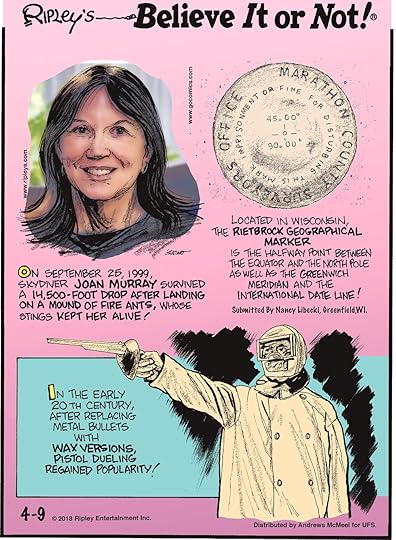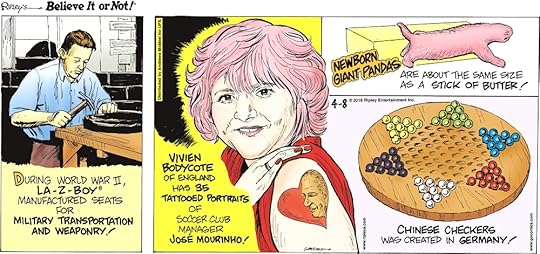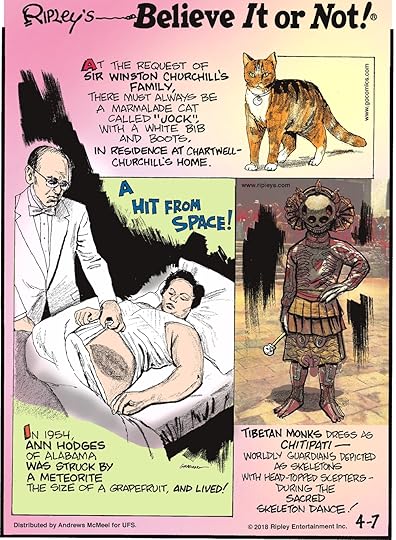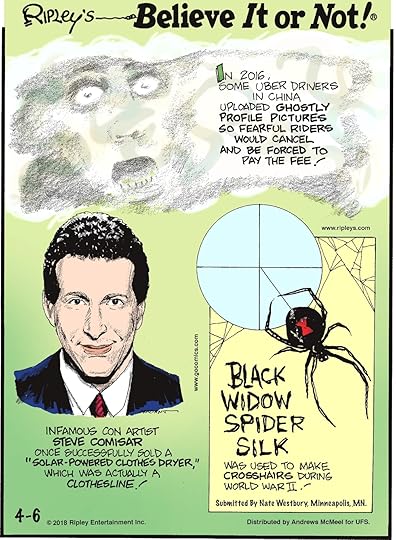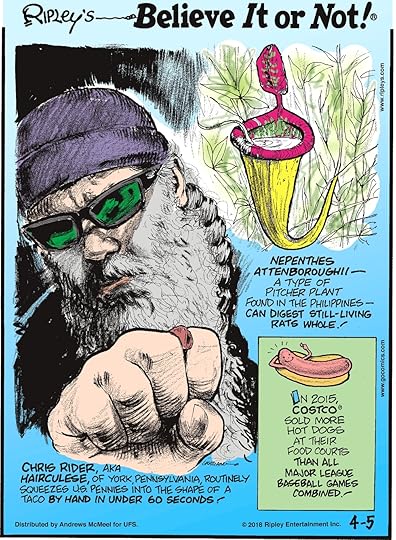Ripley Entertainment Inc.'s Blog, page 351
April 9, 2018
Meet The First Woman Of The Ejection Club
Featured in Ripley's Believe It or Not!

Lieutenant Linda (Heid) Maloney is the first woman in history to be ejected from an aircraft while flying a mission. She’s also the first woman to be inducted into a club where you have to have been thrown out before you can be let in.
The Flight
On a warm and sunny winter day in 1991, just minutes into its ascent, the vintage Northrop-Grumman EA-6A Intruder was acting sluggish and began fishtailing. Co-pilot Lt. Linda Maloney remembers the pilot saying the words she had hoped she’d never hear: “I don’t have control. Eject!” She looked at him in shock as he repeated, “Eject!”

It all seemed to happen in slow motion. Linda pulled the upper ejection handle and her seat exploded through the canopy glass. She recalls a powerful explosion and riding up the rails of the ejection seat. She’d had a pad full of paper on her lap and it was flying everywhere, giving her the sensation of yellow confetti flying throughout the cockpit. Linda lost consciousness briefly and came to when she was hanging in her parachute…drifting down towards the ocean. Her helmet visor had ripped off during the force of the ejection and her glasses were gone as well, rendering everything fuzzy. She could not see the airplane or the pilot who had ejected seconds after she did. All she could see was the ocean below and the shoreline far in the distance.
The Rescue
“After I hit the water,” Linda recalls, “I quickly got into my raft, which is part of the ejection seat that you deploy manually while in the parachute. I sat there contemplating my situation, lit off a few flares and released an orange dye marker into the water, and pulled out my radio only to find it was dead. Then I briefly scanned my body to see if I had any injuries. My chin was bleeding and I remembered the upper ejection handle smacking into my face after I pulled it. My hands and knuckles were cut and bleeding, but I didn’t seem to have any other injuries.”
“Later the pilot told me that after he ejected, he saw the aircraft continue to roll and then nosedive into the water with a formidable crash. I remember feeling very grateful to be alive and glad that the ejection seat actually worked as advertised.”
Linda soon realized that a maritime surveillance aircraft had been directed to the scene to find survivors. “I knew that they saw me because they were doing a figure eight and rocking their wings. I felt so relieved! As the aircraft approached my raft, a crew member motioned to ask if I was ok. I gave a ‘thumbs up’ and saw he was very surprised that I was a woman.”
The Club
A few weeks after the incident, Linda received a call from a Martin-Baker representative in the UK congratulating her on a successful ejection and informing her that she was being inducted into the Martin-Baker Ejection Tie Club. He asked if she wanted the commemorative tie that they bestowed upon all Martin-Baker ejectees or, something else since she was the first woman to ever be awarded this accolade.
“Not sure that I wanted a tie so I left it up to the company to decide,” Linda explains. “Soon after, I received a letter in the mail inviting me to England to officially receive a Martin-Baker pewter pin, specially designed for the first woman ejectee, to be presented by Diana, Princess of Wales. However, the Navy denied my request to travel to England for the presentation, stating that military members couldn’t be perceived as endorsing a company or product.”
Linda was very disappointed with the decision but respected it with grace. Shortly thereafter, she attended a gala in Washington, D.C. paying tribute to Martin-Baker Ejection Seats saving 6,000 lives, where she was honored and presented the commemorative pin.

Today
In the nearly three decades since that fateful yet fortuitous flight, Linda has built a business, Women Vets Speak, published a book, Military Fly Moms ~ Sharing Memories, Building Legacies, Inspiring Hope, gotten married and is happily raising two boys, Ethan and Aron. She says, “I loved my career in the Navy and I always say that I could never give the Navy back what they gave me. I’m honored to have served and am glad to pass that legacy down to my kids.” Of course, Linda still has her pin but she’s also looking into getting two Ejection Club ties…one for each of her sons.
By Kara Killen, contributor for Ripleys.com
CARTOON 04-09-2018
April 8, 2018
CARTOON 04-08-2018
April 7, 2018
CARTOON 04-07-2018
April 6, 2018
A Pepperoni and Seagull Hotel Indiscretion
Featured in Ripley's Believe It or Not!

[April 1-7th, 2018] A man is banned from basketball for being too tall, the FBI cracks its oldest case, and seagulls wreck a hotel room.
Too Tall For Basketball
Basketball players are renowned for their towering height, but apparently, there’s such a thing as too tall. Believe it or not, six-foot-seven-inch tall David Simon has been banned from the Korean Basketball League for simply being too tall. He’s one inch taller than the two-meter limit imposed.
Money Found in Ripley’s Book
Karen Austin, a Librarian at Bon Air Elementary in Pennsylvania, is pretty familiar with books, but even she was surprised when she opened a copy of Ripley’s Believe It or Not! donated to her local Goodwill. Besides the sense-shattering content, she also found eight 100-dollar bills. She informed the center and even decided to donate the money.
4,000-Year-Old Mummy Crime Solved
The FBI has finally solved the what’s sure to be its oldest case. Governor Djehutynakht and his wife were buried in an ancient Egyptian tomb 4,000 years ago. His tomb was shortly ransacked and only the severed head of a mummy survived, eventually making its way to the Boston Museum of Fine Art in 1915. Scientists were stumped determining whether the head belonged to the governor or his wife, but for the first time, managed to extract DNA from a sun-scorched 4,000-year-old mummy to determine it was in fact male.
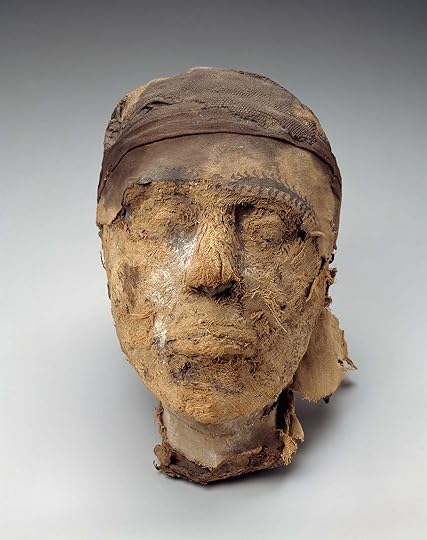
Harvard University—Boston Museum of Fine Arts Expedition
Golf Karma is Swift
While all eyes may be trained on a possible Tiger Woods revival in this year’s Masters, we noticed the exploits of 32nd-ranked Tony Finau. A long ways from the leaderboard, he still managed a Pyrrhic victory for scoring an elusive hole-in-one during the tournament. Overcome with joy he started jumping around before dislocating his ankle on the green.
Pepperoni and Seagull Incident
After 17 years of being banned from the premises of the Fairmont Empress Hotel in British Columbia, Nick Burchill can now book a room despite his infamous pepperoni and seagull indiscretion. According to a letter, Burchill left a suitcase of pepperoni on his windowsill to keep cool, drawing in a flock of up to 40 seagulls while he was away. He says when he returned, the flock got spooked, crashing into walls and light fixtures while leaving feathers and feces everywhere.
A Bouncing Pickle Law And The World’s Largest Bounce House!
Featured in Ripley's Believe It or Not!

In bathroom readers around the world, in every fact generator on the Internet, we’ve stumbled across the “fact” that Connecticut law requires pickles to bounce in order to be considered pickles.
Searching laws, regulations and ordinances, this pickle law is hard to come by. The only inkling to be found is a 1948 article about the arrest of a pair of pickle packers, Sidney Sparer and Moses Dexler, selling canned cukes “unfit for human consumption.”
In that article, the states Food and Drug Commissioner goes on to tell reporters that, in addition to laboratory testing, if you drop a pickle from the height of one foot, it should bounce.
The pickles in question did not bounce. Sparer and Dexler were fined $500—the maximum penalty—and the pickles were destroyed. Connecticut’s bouncing-pickle regulation went into effect soon after.
So, its not a law per se. Simply a regulation based off of case law.
Speaking of Bouncing…
The 20,000 square-foot Big Bounce America we were just in us kinda a big dill.
It features a DJ, confetti cannons, a basketball court, obstacle course, a giant slide that luges into a ball pit. Pretty much any and everything you could ever ask for. Did we mention it’s the largest inflatable in the WORLD?
Check out Big Bounce America as it travels the country.
Source: A Bouncing Pickle Law And The World’s Largest Bounce House!
CARTOON 04-06-2018
April 5, 2018
The Marketing Campaign That Endangered A Language
Featured in Ripley's Believe It or Not!

In 2014, news outlets began covering the tragic tale of Ayapaneco. An endangered language in the state of Tabasco in Mexico, Ayapaneco was allegedly spoken by only two men, but tragically, they refused to speak to each other over some forgotten feud. With the help of German telecom giant Vodaphone, however, the two put aside their differences in order to safeguard the language. Despite appearing on a multitude of new sites and even being documented in an expensive ad agency production we’ll include below, this story is a complete lie.
…Or NOT!
Far from having little interest in the language, linguists have been working for close to a decade to write a dictionary for Ayapaneco, and in 2008—six years before the Vodafone ad—the Mexican government began paying Isidro Velazquez—one of the alleged last two speakers—to teach children Ayapaneco, which he did with his son and four other speakers.
Years behind the movement to save the language, ad agency Jung von Matt decided to make a campaign for Vodafone. They invented a rift between Manuel Segovia and Isidro, named them the last speakers, and then claimed they reconciled the conflict and helped save the language. This fed into a campaign where people could “adopt” Ayapaneco words online, though the site for that is now defunct.
According to Suslak, who worked on the Ayapaneco dictionary, he contacted the speakers he knew in Ayapa, including Isidro and Manuel to learn why they had agreed to appear in the ads. They said that the agency wasn’t interested in the real story, and paid them to appear in the commercials, and paid the other speakers to stay out of them. All of the construction workers were paid, and a new school house wasn’t built, but instead, the company just painted the old one. That “Escuela de Ayapaneco” on the side with the two speakers smiling? They painted over it in embarrassment as soon as the film crews left.
Jhonnatan Rengel, another linguist who has studied Ayapaneco, says this campaign not only propagated erroneous information, but is dangerous to the preservation of other languages. Tons of money was spent making Ayapaneco phrases available to people who have no interest or stake in stewarding its survival. The campaign added stress to the community and created conflict between the few remaining speakers who continue to receive visits from reporters only interested in the false story. Rumors spread locally that they invented the language to receive press, and other people have found ways to exploit the language for economic gain. Suslak adds that there’s little reason for someone in Germany to learn a—often mistranslated—phrase when a resource for children in Ayapaneco would provide real enrichment.
The Real Ayapenco
Ayapaneco is spoken in the southern state of Tabasco in an area known as Ayapa. Ayapaneco is believed to be close to 600 years old, a few centuries short of the ad’s assertions, and linguist Daniel Suslak contends that only around 500 people ever spoke the language at one time.
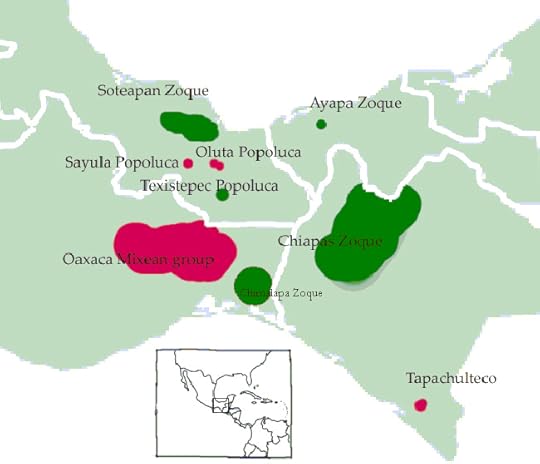
Ayapaneco has existed as a regional language surrounded by groups of more politically powerful and widespread languages like those of the Mayans, Aztecs, and Spanish. As Mexico has standardized language in schools to Spanish, and an oil boom has brought in new residents to the area, people with links to Ayapaneco have diminished.
Rengel argues the language has a unique beauty to it, with words like chük mbüünye translating to “the house of the thunder,” a very poetic way to say cloud.
Other Phrases:
xa’a nyayme: “May your heart be happy.”
axutz yu: “I am hungry.”
dyus yujaa: “Thank you.”
While the portrayal by Vodafone and a cacophony of press outlets are false in describing Isidro and Manuel as feuding hold-outs of the language, Ayapaneco is still only spoken by a handful of people. Suslak and fellow linguist Jhonnatan Rangel estimate there are around 15 speakers, noting that the definition of a speaker can be hard to pin down. Suffice to say, no one is learning Ayapaneco by living in a household that speaks it regularly, but instead, are learning it as a means to safeguard the language’s heritage. They now teach many of the city’s youth about the language, and even hold speech contests in Ayapaneco for festivals.
CARTOON 04-05-2018
April 4, 2018
The Mission To Bring The First Panda Out Of China
Featured in Ripley's Believe It or Not!
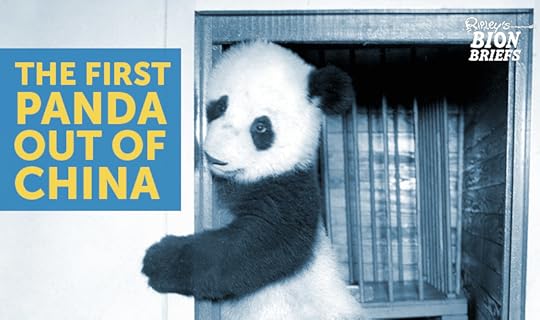
The giant panda didn’t always hold its place as a cornerstone of cute and adorable animals. Before 1936, some naturalists reported that only three westerners had even seen a living panda. It took the efforts of a New York socialite to finally bring a cuddly ball of black and white cuteness to the United States.
Ruth Harkness was a gregarious New York fashion designer. Though not much of an adventurer herself at first, the passing of her explorer husband drove her to embark on a mission to realize one of his dreams: catch a panda.
Pandas at this time were not well known. Only discovered in 1869 by the west, scientists for a long time had only a pelt as evidence the bears existed at all. The first westerner to see a panda only did so 20 years before Harkness captured one. The only other people outside China to see a panda before that are believed to be two of Teddy Roosevelt’s children—Teddy Junior and Kermit—who shot a bear before taking its body home.
To Catch A Panda
Arriving in China, Harkness recruited the help of 22-year-old Chinese-American, Quentin Young, to guide her through bandit occupied forests in search of a panda. Escorted by a crew of 16, they hiked into the mountain forests. Harkness and Young quickly fell into an affair during their two-month journey but were rewarded for their patience after finding a baby panda. They had heard a gunshot while hiking together and spotted what they assumed to be a cub that had just lost its mother. Not waiting around to investigate further, they left with the baby bear.
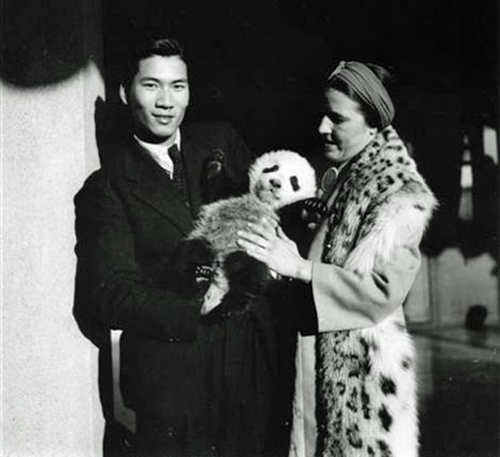
Harkness was infatuated and named the baby bear Su Lin, meaning “a little bit of something precious.” They did their best to care for Su Lin on their way back to Shanghai, feeding him powdered milk. When she tried to depart, however, customs officials confiscated Su Lin. Missing her boat, Harkness spent all night in the pen with her baby panda before convincing officials to let her depart with her “dog” according to official papers.
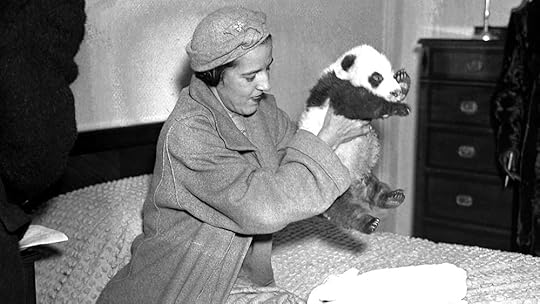
Once the duo arrived in America, Harkness cared for the playful cub in her apartment before eventually selling him to the Chicago Zoo. There, pandamonium struck the country. For the first time ever, people were enthralled by the infectious cuteness of pandas, and zoos scrambled to find more.
Another 13 pandas would be taken out of China for zoos, but unfortunately, none would survive for very long.
Panda Diplomacy
For its help in ending Sino-Japanese conflicts, China decided it wanted to ship two of its highly prized pandas to the United States as a sign of friendship. They assigned a missionary to procure the creatures, and it would be Dr. David Crockett Graham who would lead a political mission to transport pandas back home to America. Though he would brave the remote Chinese wilderness, traversing bridges made of just bamboo cable and involving 70 hunters and 40 dogs, he eventually just bought two pandas from locals before embarking on a ship home.
Though he knew his mission was of grave importance to China, he couldn’t have prepared for what would happen during the 35,000-mile sea voyage home. Pearl Harbor was attacked by the Japanese. Fearing bombardment by warplanes, Graham had the ship covered in camouflage material and even considered camouflaging the bear’s unique colors to pass unnoticed. The pandas would eventually arrive safely at the Bronx Zoo, in a feat that China would mirror many times as a sign of diplomatic peace, sending pandas to Britain and Russia.

Ling-Ling and Hsing-Hsing, the pandas Nixon received.
You Can Rent Pandas
Though China stopped exporting its pandas for a time starting in 1946, they did gift a pair to president Nixon after his visit in 1972. He had an embarrassing moment speaking with reporters fearing they needed to be taught how to mate, but the two pandas would become America’s first to live long healthy lives. They delivered five cubs, but none survived, highlighting the difficulties of breeding pandas.
Today China only loans out its pandas in cooperative breeding efforts. Still, renting a panda demands a price tag of up a million dollars per year.
Ripley Entertainment Inc.'s Blog
- Ripley Entertainment Inc.'s profile
- 52 followers


